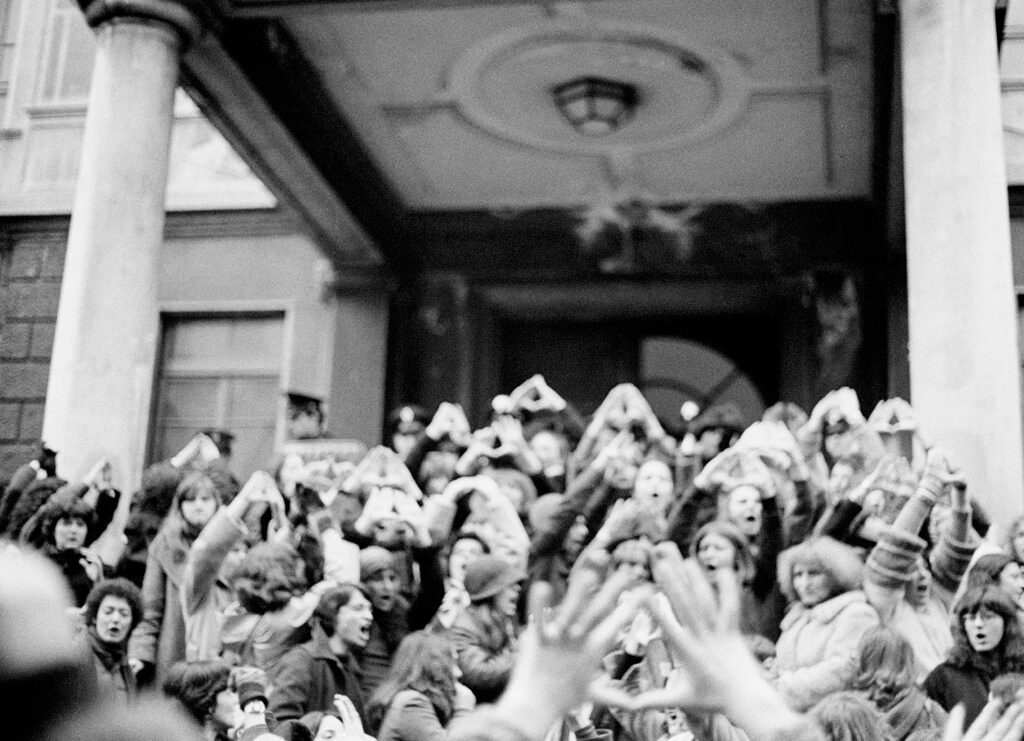Indexes and thumbs touch above the demonstrators’ heads, spaces of possibility open between fingers. A new collective subject embodies in the streets of Milan in 1978. People run, overtaking the tram. In the faces blurred by the run, we may catch a smile towards the camera. We’re not looking at the famous photographs of the Italian feminist movement taken by Paola Agosti or Paola Mattioli, but at those of the then twenty-years-old Marisa Licini, collected by her daughter Nicoletta Grillo, from films she found only after her passing. We encounter these images, together with some writings by Marisa Licini, in the photobook Noi, published by Boîte Editions, and in the exhibition Caro amore, at Careof (Milano) and Focus Artphilein (Lugano).
In 1978, often recalled as a fundamental year for the Italian feminist movement, Marisa Licini had just graduated from the Istituto d’Arte in Monza. It was a school with an advanced program that saw together the experience of teachers with a “rational” background and the research of those, like Ugo La Pietra, who contested that rationality in favour of releasing creative energies in the direct approach to urban form and the life conducted therein. One and other teachers were in a necessarily ambivalent position. On the one hand, they informed a new generation with relevant artistic languages. On the other, they were still repositories of cultural legacies against which we can imagine that a teenage girl of those years could now clearly perceive a rupture. Specifically concerning the normativity of gender relations, whose acceptance – conscious or not – is already political, as stated in the title of a book by Rivolta Femminile (È già politica) published that same year. Against all that, equally present in the artistic scene as in the rest of society, the feminist movement moved its action, developing visual tools for deconstructing and unveiling those gender norms.
So the book’s first pages recollect the pictures of a feminist demonstration. Nicoletta Grillo intervenes on the photographs isolating details. One after the other, we see close-ups of demonstrators caught in the act of singing, laughing or shouting. The faces acquire a vibration in such strong blowups, which highlight the film grain. It seems that the stillness of the image is on the verge of collapsing, connecting us with the moment of that action. The central pages of the book alternate photographs shots in private spaces and images of cities, as seen in their more ordinary aspects rather than at the time of the demonstrations. The blowup process is applied this time to the hands of friends portrayed by Marisa Licini. The urban exteriors appearing here are mostly large suburban housings, which had arisen in the last few years in the terrains at the edge of the city. We may notice the community vegetable gardens leaning against buildings, and the paths carved out in the meadows from the passage of people towards the blocks: signals of the emergence of the unceasing dialectic between the rushed expansion of an urban form and the physical existence of the people who by necessity find themselves living there. A dialectic that is often implicit, because rooted in everyday experience: it is precisely from the representation of that everyday life that the notion, so dear to those years’ movements, that “the private is politics” can shine through.
From the series of images from everyday life emerge moments of summer vacations, resulting in seascapes, towards the end of the book. Some words are taken from Marisa Licini’s notebook pages. In one of these, she writes about the sense of oppression provoked by a male gaze, a gaze that is heavy and suffocating, responding to the logic of possession. A sort of counter-representation is proposed in the subsequent photographs, which portray a friend leaning on the beach at night. In a series of blowups, we approach her body’s silhouette, probably illuminated by a bonfire: it seems to compose itself by shapes of the whitest light, once again vibrating for the grain against the dark backdrop. A drawing of light, almost a pure synthesis of the technical process that leads to the photographic image: an “original” image from which to re-found our gaze. The book closes right after with three colour shots, two of a sunset, or a sunrise, on the sea, which frame a self-portrait from the young photographer.


This work seems to propose an attempt to re-design the categories of authorship and artistic subjectivity in our relationship with images. No more an “I” subject who perceives “You” and “Them” as objects of my perception, but a “We” (Noi), a collective artist where Nicoletta Grillo, Marisa Licini, her companions of 1978, and us who approach their path, could meet. Images and words, entities from a non-binary universe which overcomes subject and object. In the intersection between the many subjectivities involved, we may re-think and question unidirectionality in our perception of images, between (self)representations of affections, places, private and collective life. It may be useful to add that Nicoletta Grillo’s interests in her academic research is directed towards spatial and photographic practices that question the perception and representation of borders. Questioning borders and their visibility or not, and for whom, means questioning once more a threshold between a subject and an “other”, who towards that threshold lives in a different regime of law. As it brings us to question perceptual schemes often taken for granted, breaking the idea of a binary perception of relations not only between human subjectivities, but also between human subjects and the territory, photographs can play a role in re-negotiating territorial and social assets: from perceiving to being in the world.
Nicoletta Grillo is a visual artist and researcher. After studying architecture (Politecnico di Milano) and photography (CFP Bauer), she obtained a PhD with a thesis on photography and spaces of imagination in border landscapes (Politecnico di Milano and KU Leuven, 2022). She is currently a postdoctoral researcher at LUCA School of Arts and a lecturer at KU Leuven, Belgium. In 2022, Boîte Editions published her photo book “Noi”. Recent exhibitions include “Caro amore” (solo, Careof, Milan, and Focus Artphilein, Lugano), “Intangible Thresholds” (SUPSI library, Mendrisio), and “Le stanze del contemporaneo” (Palazzo Martinengo, Brescia).



















